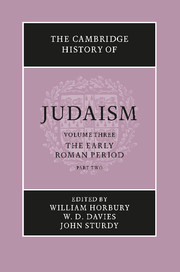Book contents
- Frontmatter
- 1 The archaeology of Palestine 63 bce–ce 70
- 2 The Herodian Temple
- 3 Recent archaeology in Palestine: achievements and future goals
- 4 The contribution of Jewish inscriptions to the study of Judaism
- 5 The social, economic and political history of Palestine 63 bce–ce 70
- 6 The Diaspora in the Roman period before ce 70
- 7 The Gentiles in Judaism 125 bce–ce 66
- 8 Gentiles as seen by Jews after ce 70
- 9 The synagogue
- 10 The Temple and the synagogue
- 11 The early liturgy of the synagogue
- 12 Women in the synagogue
- 13 The Pharisees
- 14 The Sadducees – their history and doctrines
- 15 The Essenes
- 16 The baptist sects
- 17 The troublemakers
- 18 The Samaritans and their sects
- 19 Galilean Judaism and Judaean Judaism
- 20 Jesus: from the Jewish point of view
- 21 Paul: from the Jewish point of view
- 22 Jewish Christianity
- 23 Apocalyptic: the disclosure of heavenly knowledge
- 24 The Qumran sectarian writings
- 25 The Dead Sea Scrolls and pre-Tannaitic Judaism
- 26 Prayer in the Qumran Texts
- 27 Philo of Alexandria
- 28 Josephus (ce 37–c. 100)
- 29 The rabbi in second-century Jewish society
- 30 The Hellenistic–Roman Diaspora ce 70–ce 235: the archaeological evidence
- 31 The legacy of Egypt in Judaism
- 32 Jewish elements in gnosticism and magic c.ce 70–c.ce 270
- Bibliographies
- Index
- References
1 - The archaeology of Palestine 63 bce–ce 70
Published online by Cambridge University Press: 28 March 2008
- Frontmatter
- 1 The archaeology of Palestine 63 bce–ce 70
- 2 The Herodian Temple
- 3 Recent archaeology in Palestine: achievements and future goals
- 4 The contribution of Jewish inscriptions to the study of Judaism
- 5 The social, economic and political history of Palestine 63 bce–ce 70
- 6 The Diaspora in the Roman period before ce 70
- 7 The Gentiles in Judaism 125 bce–ce 66
- 8 Gentiles as seen by Jews after ce 70
- 9 The synagogue
- 10 The Temple and the synagogue
- 11 The early liturgy of the synagogue
- 12 Women in the synagogue
- 13 The Pharisees
- 14 The Sadducees – their history and doctrines
- 15 The Essenes
- 16 The baptist sects
- 17 The troublemakers
- 18 The Samaritans and their sects
- 19 Galilean Judaism and Judaean Judaism
- 20 Jesus: from the Jewish point of view
- 21 Paul: from the Jewish point of view
- 22 Jewish Christianity
- 23 Apocalyptic: the disclosure of heavenly knowledge
- 24 The Qumran sectarian writings
- 25 The Dead Sea Scrolls and pre-Tannaitic Judaism
- 26 Prayer in the Qumran Texts
- 27 Philo of Alexandria
- 28 Josephus (ce 37–c. 100)
- 29 The rabbi in second-century Jewish society
- 30 The Hellenistic–Roman Diaspora ce 70–ce 235: the archaeological evidence
- 31 The legacy of Egypt in Judaism
- 32 Jewish elements in gnosticism and magic c.ce 70–c.ce 270
- Bibliographies
- Index
- References
Summary
The period under discussion coincides roughly with what is usually called the Early Roman or Herodian period. While the former term is quite accurate and somewhat neutral, the latter is rather more appropriate. Our period bears the sharp imprint of Herod and his dynastic successors, who ruled the country from 37 bce onward. Unlike many periods bearing the names of a monarch, but actually owing very little to him (e.g. ‘Edwardian’), many of the features of the Herodian period were indeed shaped by Herod himself – the greatest builder in the history of Palestine and one of the outstanding builders of all antiquity. Herod introduced new styles and building methods into the country and built on a monumental scale and to an unparalleled extent: cities, fortresses, palaces, a large harbour and the most magnificent building ever to be built in Palestine, the Jerusalem temple complex. Many of these monuments which were preserved because of their size or sacred character (e.g. the Temple Mount, the Cave of Machpelah) or because of their location in desert areas, where the remoteness and climate ensured their survival (e.g. Masada) have given us a better knowledge of the Herodian period than of any other period in the history of the country.
The beginning of modern research into this period was ushered in by the explorations of the American scholar Edward Robinson who, as early as 1838, noted in Jerusalem the skewback of an Herodian arch, now bearing his name, and correctly identified remains of the ‘Third Wall’ as well as the sites of Masada, Herodion and others. The Frenchman F. de Saulcy was the first to excavate in Jerusalem, clearing the so-called Tombs of the Kings in 1854, and in 1864 the British Charles Wilson began his series of soundings around the Temple Mount, thus initiating the modern scientific approach. Archaeological activity has hardly stopped ever since.
- Type
- Chapter
- Information
- The Cambridge History of Judaism , pp. 1 - 37Publisher: Cambridge University PressPrint publication year: 1999
References
- 1
- Cited by



